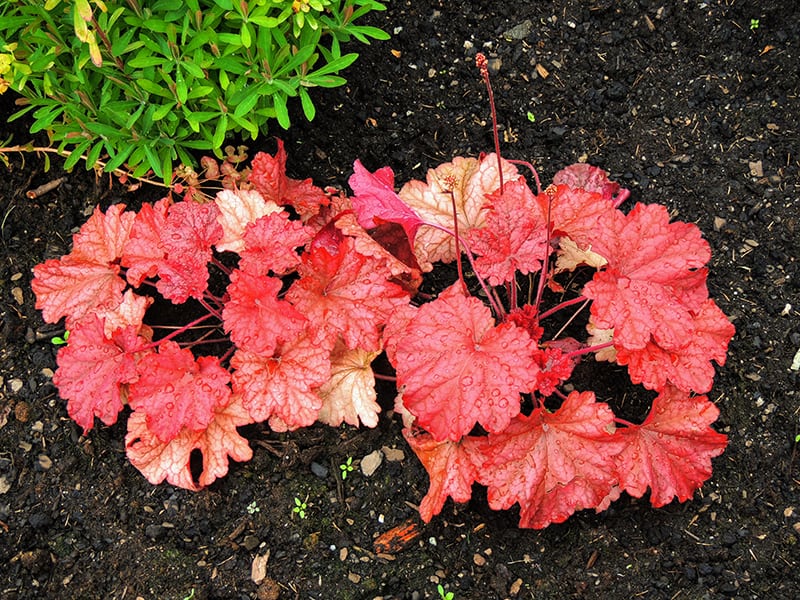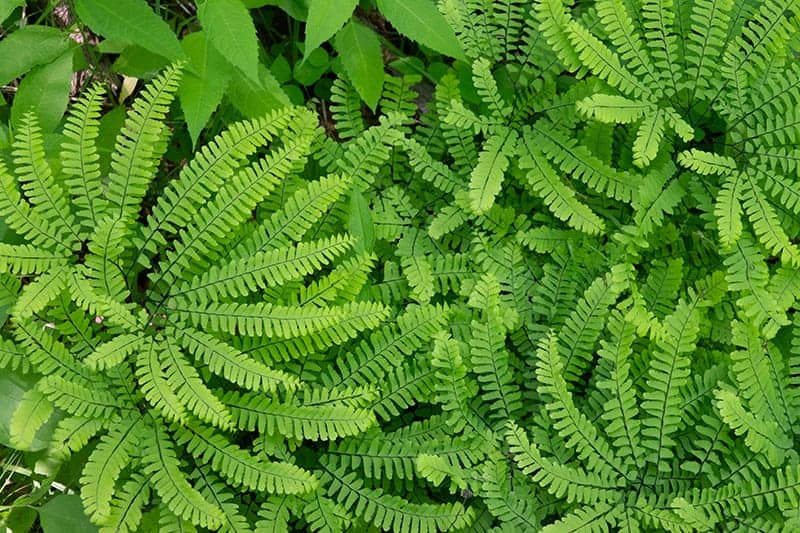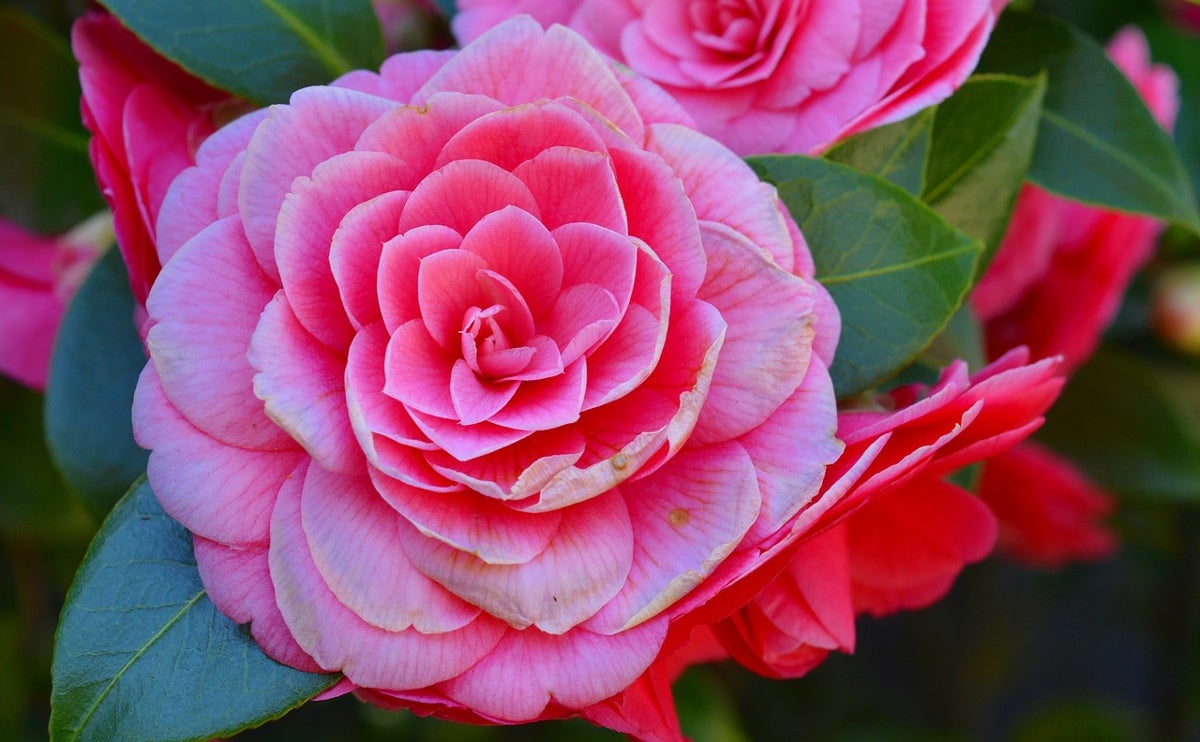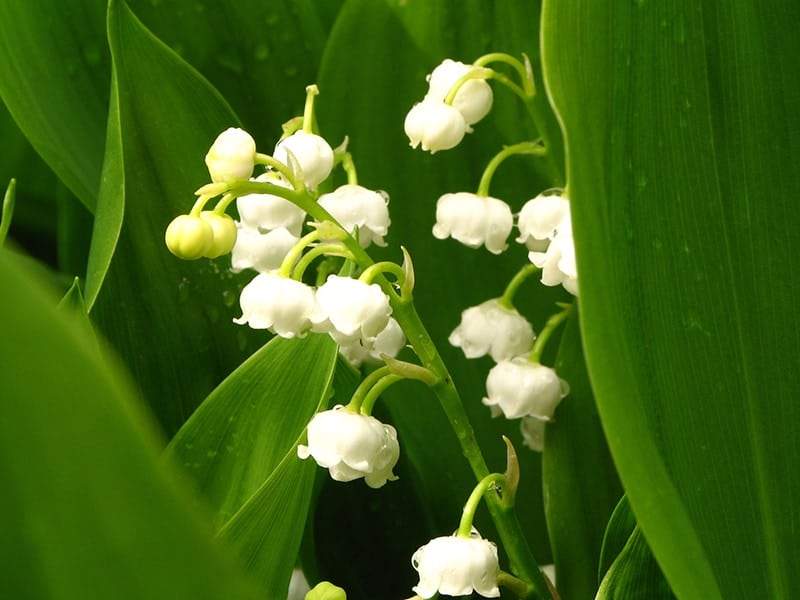Have you ever used a bag of commercial potting soil? If so, you may have n... Read More
- Home >
- 13 Best Shade-Loving Plants For Shady Spots
13 Best Shade-Loving Plants For Shady Spots

Shade-loving plants are great for brightening up dark corners of the garden where most plants will not grow. They also make great ground cover underneath trees or space-fillers in between larger shrubs and plants. This list includes some of the best plants for shady spots.
Shade-Loving Plants
1. False Goat’s Beard

Scientific Name: Astilbe
Mature Size: Up to 3 feet tall
USDA Hardiness Zone: 3-9
Light: Partial shade to full shade
Water: Maintain moist soil
Soil: Well-draining, organically rich
Flower Color: Purple, pink, white
Cultivars and Varieties: Astilbe simplicifolia ‘Sprite’, Astilbe japonica ‘Rheinland’, Astilbe chinensis ‘Maggie Daley’
These hardy perennials produce mounds of glossy fern-like foliage that unfurls in a bronze tone in the spring before developing to a shade of dark green. Large flower panicles arrive in mid to late summer, which rises above the foliage and then softly droops. The panicles are adorned with lots of tiny blooms in shades of pink, purple, or white, depending on the variety of the plant.
These plants are easy to grow and require very little maintenance. They work great in shaded gardens as they thrive in partial shade or full shade. They enjoy a well-draining soil with a good percentage of organic content, which is kept consistently moist. These plants should not be allowed to dry out and would benefit from mulching to prevent moisture loss. They work well in containers or borders and are well suited to moist and humid areas such as beside a pond or stream.
2. Painted Lady Fern

Scientific Name: Athyrium niponicum var. pictum
Mature Size: Up to 2 feet tall
USDA Hardiness Zone: 3-9
Light: Partial shade to full shade
Water: Maintain moist soil
Soil: Well-draining, fertile, acidic
Cultivars and Varieties: Athyrium niponicum var. pictum ‘Burgundy Lace’, Athyrium niponicum var. pictum ‘Metallicum’, Athyrium niponicum var. pictum ‘Silver Falls’
This is a deciduous plant that is native to northeastern Asia and grown for its striking and elegant foliage. Lance shaped fronds are produced in large rosettes, and gently arch outwards, The coloring of the foliage is this plant’s most interesting feature, as fronds have dark purple stems and midribs, from that small blue-green leaves with silver accents are held. This plant naturalizes easily in ideal conditions, to form colonies of clumps. It grows best in partial or full shade and requires consistently moist soil. Though it prefers well-draining soil, it will tolerate a range of soils, including wet and clay soil, though it cannot tolerate dry soil. It should be protected from strong winds and heavy rain and works well when grown underneath taller shrubs or trees.
3. Hardy Begonia

Scientific Name: Begonia grandis
Mature Size: Up to 3 feet tall
USDA Hardiness Zone: 6-11
Light: Partial shade to full shade
Water: Maintain moist soil
Soil: Well-draining, acidic, rich
Flower Color: Pink, orange, red
Cultivars and Varieties: Begonia grandis ‘Garden Angel Silver’, Begonia grandis’ Garden Angel Plum’, Begonia grandis ‘Garden Angel Blush’
This evergreen perennial forms mounds of foliage that are shaped like maple leaves. The leaves are dark green with pale green and white accents, and this attractive foliage is the primary reason that these plants are grown. They also produce pretty flowers in late summer on erect stems that reach above the foliage below. These are low-maintenance plants that grow well in shady areas of the garden and will survive year-round in warm climates. They need continually moist soil that should not be allowed to dry out, and ideally, should be mulched to retain moisture. They grow quickly to heights of up to three feet, with a similar-sized spread. Ensure good circulation around the plants to prevent disease.
4. Siberian Bugloss

Scientific Name: Brunnera macrophylla
Mature Size: Up to 2 feet tall
USDA Hardiness Zone: 3-8
Light: Partial shade to full shade
Water: Maintain moist soil
Soil: Well-draining
Flower Color: Blue
Cultivars and Varieties: Brunnera macrophylla’ Looking Glass’, Brunnera macrophylla’ Jack Frost’, Brunnera macrophylla ‘Diane’s Gold’
This deciduous perennial produces dense mounds of interesting foliage, which can vary from creamy pale green to neon lime green. The leaves are heart shaped with heavy veining, and they provide some bright color to dark and shaded parts of gardens. In spring, bursts of delicate flowers appear as an added bonus to this plant’s attractive foliage. The plant spreads slowly through creeping underground rhizomes. Siberion bugloss can be planted individually as specimen plants in containers or borders, or they work well as ground cover over time.
The flowers will turn to seed and easily reseed to create new plants, so ensure that spent flowers are deadheaded if you don’t want more Siberian bugloss. Grow this plant in a well-draining soil that is rich in organic content. Do not let the soils dry out, and keep the plants in a shaded area. These plants prefer cool weather and will not tolerate hot or dry conditions.
5. Camellia

Scientific Name: Camellia japonica
Mature Size: Up to 15 feet tall
USDA Hardiness Zone: 6-10
Light: Partial shade to full shade
Water: Maintain moist soil
Soil: Well-draining, acidic, rich
Flower Color: Red, pink, white
Cultivars and Varieties: Camellia japonica ‘Lady Campbell’, Camellia japonica ‘Lavinia Maggi’, Camellia japonica ‘Korean Fire’
These are evergreen shrubs that are native to Asia. They vary in size depending on variety, with average mature heights ranging from eight feet to fifteen feet. They have moderate growth habits, and contrary to popular belief are very easy to grow. These plants have dark green foliage that is narrow and glossy and remains attractive throughout every season. Flowers bloom in late winter and persist right through to spring. Blooms can be single, semi-double, or full double, and have a look similar to peonies. They vary in color between varieties, with some producing large flowers of up to five inches across.
Some camellia enjoy full sun, but there are many that will grow best in part shade or full shade. If you are looking for a camellia to use in a shaded area, ensure you select a variety that is shade-loving, such as those listed here. Grow these plants in well-draining soils and do not allow them to dry out. They should be sheltered from cold winds and kept out of direct sunlight.
6. Coral Bells

Scientific Name: Heuchera
Mature Size: Up to 3 feet tall
USDA Hardiness Zone: 4-9
Light: Partial shade to full shade
Water: Average water needs
Soil: Well-draining, rich
Flower Color: White
Cultivars and Varieties: Heuchera ‘Citronelle’, Heuchera ‘Ginger Ale’, Heuchera ‘Green Spice’
These perennials are grown for their glowing foliage that comes in a range of colors, from lime green to luminous orange or purple. Leaves have varying shapes, but all are wide with rounded edges, some of that are ruffled or curled. These plants are semi-evergreen and maintain their bright colors throughout the growing season. Coral bells also produce tall panicles of small white flowers in late spring or early summer.
Though some of these plants will thrive in full sun, most prefer shade. Seek out a shade-loving variety if you want to brighten up your shaded areas with some vibrant coral bells. These plants enjoy rich and well-draining soil that is kept moist for younger plants but can be allowed to dry out when plants are mature. They are very versatile and can be used as ground cover, in containers, beds and borders, and even in rock gardens.
7. Plantain Lily

Scientific Name: Hosta
Mature Size: Up to 2 feet tall
USDA Hardiness Zone: 3-9
Light: Partial shade to full shade
Water: Average water needs
Soil: Well-draining
Flower Color: Purple, blue
Cultivars and Varieties: Hosta ‘Alligator Alley’, Hosta ‘Angel Falls’, Hosta ‘Blue Mouse Ears’
These perennial plants form large mounds of attractive foliage in a number of colors and styles. Leaves are generally large and ovate, with many varieties having glossy or satin smooth foliage. Leaf color can be gold, blue, or various shades of green, and many varieties are variegated with flashes of cream. These plants are grown for their interesting foliage, but they do also produce flowers in summer. Blooms are purple or blue and appear on tall racemes that reach out from the clumps of foliage. These plants are a great choice for adding color to dark shaded corners, though some varieties perform better in the shade than others. Even those that thrive in full shade may be tolerant of some sun. These plants are not fussy about soil type and will succeed in a wide range of soil types, though they prefer well-draining and consistently moist soil.
8. Japanese Spurge

Scientific Name: Pachysandra terminalis
Mature Size: Up to 1 foot tall
USDA Hardiness Zone: 4-9
Light: Partial shade to full shade
Water: Average water needs
Soil: Well-draining
Flower Color: White
Cultivars and Varieties: Pachysandra terminalis ‘Green Sheen’, Pachysandra terminalis ‘Silver Edge’, Pachysandra terminalis ‘Green Carpet’
This perennial plant has a creeping nature, which spreads underground through runners, to form a dense carpet just above soil level. It is ideal for use as ground cover and is utilized as a means of soil erosion on sloping ground thanks to its strong and complex root system. This is a shrubby but low growing plant, which grows rapidly to the full size of up to one foot, though it is typically a few inches less than this. It will spread widthwise to size around double its height, making it great for quickly filling in empty spaces between plants.
The foliage of this plant is deep green with a satin finish. It produces small spikes of creamy white flowers in the spring, but these are largely thought of as insignificant. Japanese spurge thrives in partial or full shade and is perfect for growing underneath taller shrubs or trees. It is tolerant of many growing conditions, including clay soil and dry soil. Though the plant is drought tolerant, once mature, it will perform best in consistently moist soils, and your aim should be to not allow the soil to dry out.
9. Lungwort

Scientific Name: Pulmonaria officinalis
Mature Size: Up to 1 foot tall
USDA Hardiness Zone: 3-9
Light: Partial shade to full shade
Water: Maintain moist soil
Soil: Well-draining
Flower Color: Blue, pink, purple
Cultivars and Varieties: Pulmonaria officinalis ‘Blue Ensign’, Pulmonaria officinalis ‘Shrimps on the Barbie’, Pulmonaria officinalis ‘Trevi Fountain’
These plants are perennials that are evergreen in warm winter climates, and semi-evergreen in cooler regions. They produce clusters of trumpet-shaped flowers in bright shades of pink, blue, or purple, depending on the variety. Flowers typically bloom early on in spring, and flowering stems should be cut back after blooms have faded to keep the plant looking neat and tidy. After blooming, the plant remains attractive thanks to its dense mounds of dark green foliage.
This plant has creeping roots that cause it to spread slowly. It will usually grow to a width double the size of its height, at approximately two feet. Lungwort is a popular choice for groundcover, but it also works well in borders or containers. It thrives in partial or full shade and a well-draining, consistently moist soil. It is not tolerant of high heat levels, and in warmer climates will fare best in full shade where it can remain cool. This is an exceptionally easy to grow plant, which has received the Award of Garden Merit from the Royal Horticultural Society (Missouri Botanical Gardens).
10. Maidenhair Fern

Scientific Name: Adiantum aleuticum
Mature Size: Up to 3 feet tall
USDA Hardiness Zone: 3-8
Light: Partial shade to full shade
Water: Maintain moist soil
Soil: Well-draining
Cultivars and Varieties: Northern Maidenhair Fern-Adiantum pedatum, Himalayan Maidenhair Fern-Adiantum venustum, Southern Maidenhair Fern-Adiantum capillus veneris
These North American native perennials can be deciduous or semi-evergreen. They are grown for their highly attractive foliage, which is made up of sword-shaped fronds. These fronds have a central wiry spine, from that triangular pinnules in bright green are arranged consecutively. The fronds fan out at horizontal angles to form a loose rosette shape. This plant gives a lush and exotic feel to landscapes, and like most other ferns, it thrives in the shade. It is ideal for bringing some interest into dark and drab areas of the garden and works especially well in naturally moist habitats such as near a stream or pond. This fern needs consistently moist soil but will not tolerate wet or boggy soil, and therefore should be grown in well-draining soil. It can suffer from scorched leaves during the summer and so should be kept out of direct sunlight, especially in the afternoons. This fern has won the Award of Garden Merit from the Royal Horticultural Society.
11. Carpet Bugle

Scientific Name: Ajuga reptans
Mature Size: Up to 1 foot tall
USDA Hardiness Zone: 3-10
Light: Partial shade to full shade
Water: Maintain moist soil
Soil: Well-draining
Flower Color: Blue
Cultivars and Varieties: Ajuga reptans ‘Blueberry Muffin’, Ajuga reptans ‘Chocolate Chip’, Ajuga reptans ‘Black Scallop’
These evergreen perennial plants have a vigorous growth habit that spreads quickly to form a carpet of rosettes, hugging the ground as it goes. New foliage growth appears in the spring in a deep bronze before turning dark green. The leaves are thick and densely packed together, with a leathery texture. Spikes of blue flowers emerge in spring, which has an attractive lavender hue. The flowers bloom in such abundance that they almost create a new carpet of their own. Though the flowers of the carpet bugle are very pretty, most gardeners grow this plant primarily for its attractive foliage and its use as ground cover.
Its quick growth habit and showy foliage make it ideal for filling in gaps between other plants, particularly underneath the shade of trees or shrubs. It also works well in containers and is useful to help prevent erosion on slopes and banks. This plant will tolerate almost any soil type, even clay soils, though it will not grow well in dry soils. As long as the soil is kept continually moist, it will also adapt to a range of lighting conditions; however, it prefers shade and will grow best in dark and moist environments. Carpet bugle is very low-maintenance, and can even be mown after flowering to remove the flower stems in one swift move.
12. Wood Anemone

Scientific Name: Anemone nemorosa
Mature Size: Up to 10 inches tall
USDA Hardiness Zone: 5-8
Light: Partial shade to full shade
Water: Maintain moist soil
Soil: Well-draining, acidic, rich
Flower Color: Yellow, white, purple
Cultivars and Varieties: Anemone nemorosa ‘Robinsoniana’, Anemone nemorosa ‘Vestal’, Yellow Wood Anemone-Anemone ranunculoides
This perennial plant is a dwarf species that rarely exceeds ten inches in height but spreads to more than two feet across. It has a creeping nature, spreading underground by utilizing rhizomes. This plant will naturalize easily in ideal conditions, and create patches of colonies to give the look of a beautiful and dense carpet. Wood anemone has dainty looking medium green foliage but is mostly grown for its flowers.
The flowers arrive in early to mid-spring, held on upright stems that sit just slightly higher than the mat of foliage. Flowers are single blooms, and are usually white, but can also be flushed with purple or other colors depending on the variety. Flowers are very responsive to the sun and will close up and droop on dull days. On sunny days, they will stand to attention with wide-open faces and follow the movement of the sun. This plant blooms prolifically, creating a mass of cute star-shaped flowers. It grows best in partial shade or full shade and needs a consistently moist soil during growing seasons.
The plant will enter dormancy when temperatures rise in the summer, and it does have some tolerance of drought in this state. It prefers acidic, rich, and well-draining soil. Mulching the soil is recommended to preserve moisture in the soil. Be careful when handling this plant as its sap can cause skin irritation.
13. Italian Arum

Scientific Name: Arum Italicum
Mature Size: Up to 2 feet tall
USDA Hardiness Zone: 5-9
Light: Partial shade to full shade
Water: Maintain moist soil
Soil: Well-draining
Flower Color: Yellow, green
Cultivars and Varieties: Arum Italicum ‘Pictum’, Arum Italicum subspecies ‘Marmoratum’
This European native is a tuberous perennial. It is a plant that appears to do everything on an unusual timescale; its foliage is dormant throughout spring and summer, with new leaves emerging in the fall and growing throughout winter. Flowers of this plant appear in spring and are made up of a yellow-green spathe with a central yellow spadix. These blooms will be replaced by clusters of berries in the summer, which is a vibrant orange-red, and have a glossy exterior. The plant is noted for its interesting foliage, which is shaped like an arrow. The leaves are dark green with creamy variegation that varies depending on the species or variety.
This plant thrives in partial or full shade, where it will gradually naturalize. It forms clumps over time and performs best in a moist and well-draining soil. Italian arum is tolerant of a range of soil types, and will even survive in wet soil. It is very low-maintenance and is ideal for planting underneath shrubs and trees, or in shaded borders.
Related Content
-
What is Perlite? What is its use in the garden?
-
8 Best Bedroom Plants That Purify The Air & Improve Your Sleep Quality
If you’ve been thinking of adding some plants to your sleeping quarters, t... Read More
-
Top 15 Most Beautiful Flowers You Can Grow In Your Garden Immediately
"Flowers are the music of the ground. From earth's lips spoken without sou... Read More
-
Different Types of Earthworms with Pictures & Facts
There are many types of worms, but those that we commonly encounter in our... Read More


